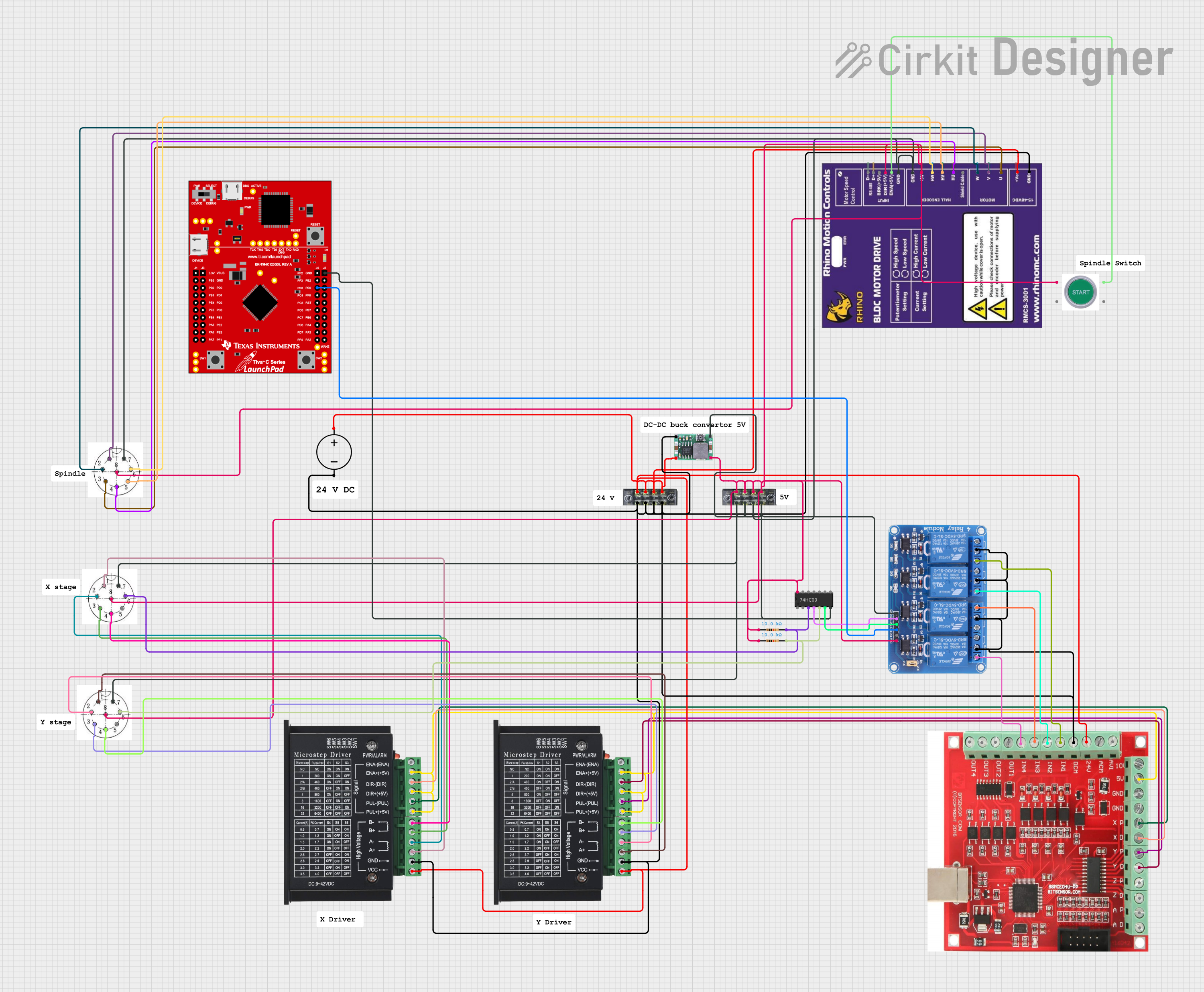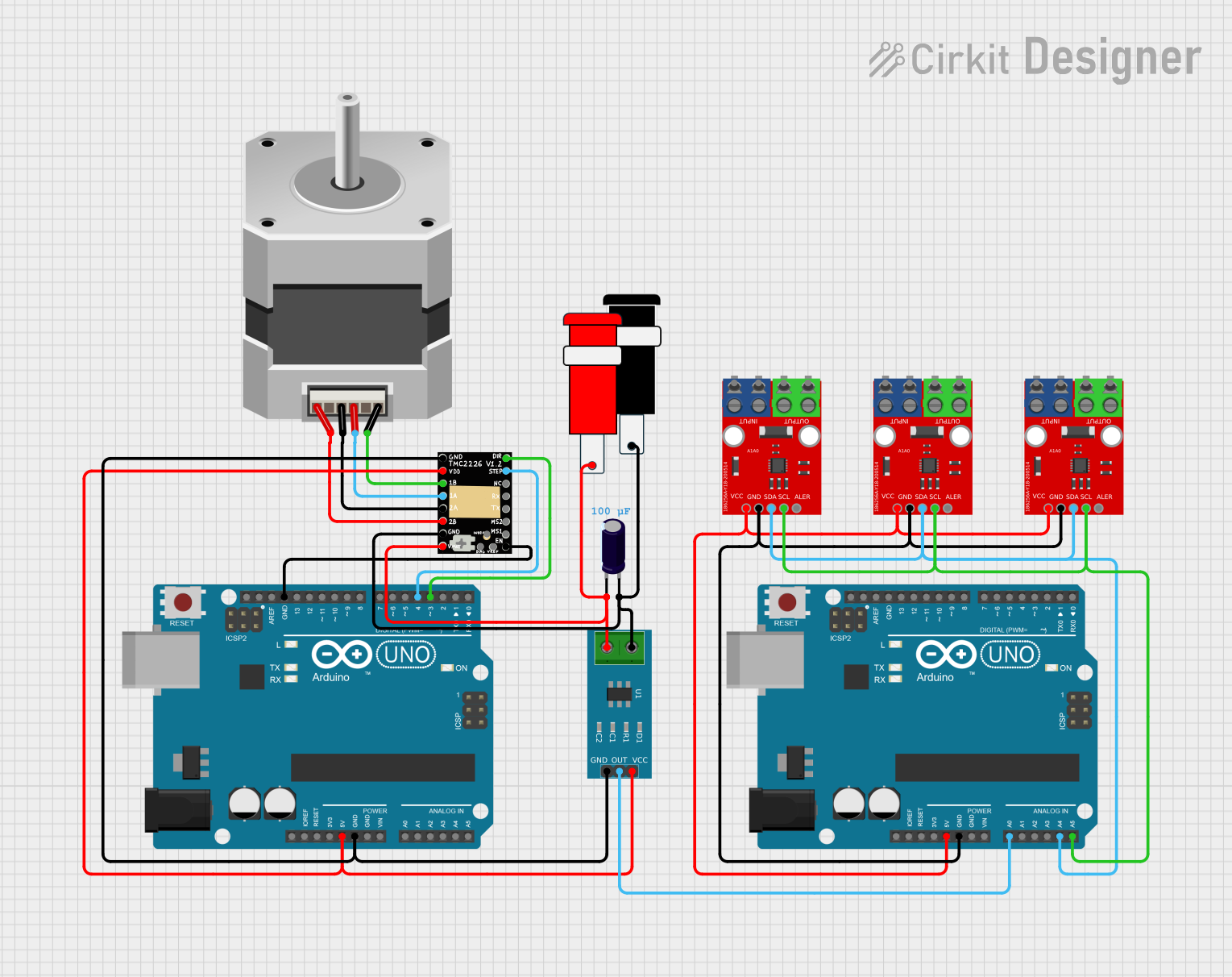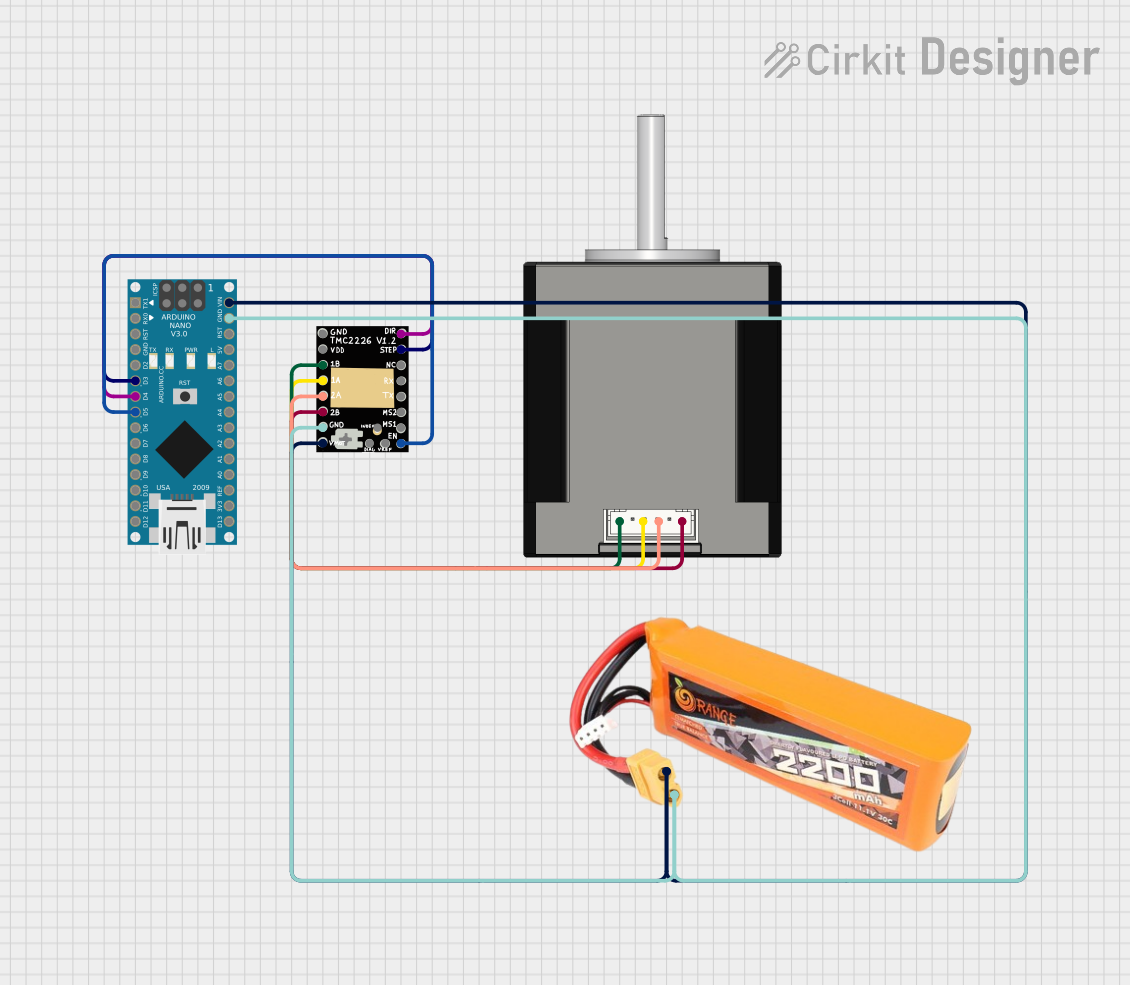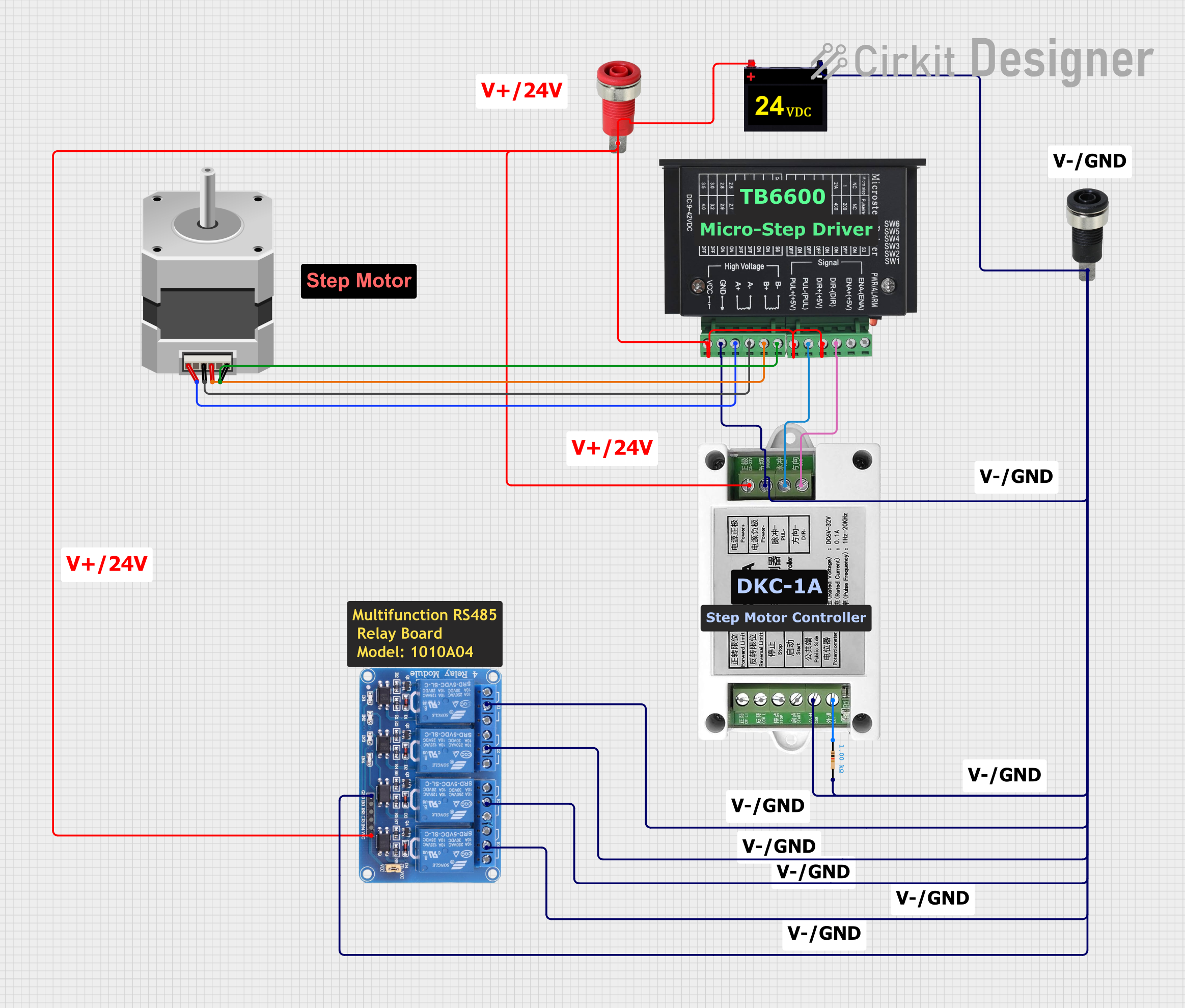
How to Use TMC2209 MOTOR DRIVER(V 2.0): Examples, Pinouts, and Specs

 Design with TMC2209 MOTOR DRIVER(V 2.0) in Cirkit Designer
Design with TMC2209 MOTOR DRIVER(V 2.0) in Cirkit DesignerIntroduction
The TMC2209 MOTOR DRIVER (V 2.0), manufactured by MakerBase (MKS), is a high-performance stepper motor driver designed for silent and efficient operation. It features advanced current control, microstepping capabilities, and stall detection, making it ideal for applications requiring precise motor control. This driver is widely used in 3D printers, CNC machines, and other motion control systems. Its UART interface allows for easy configuration and real-time monitoring, making it a versatile choice for both hobbyists and professionals.
Explore Projects Built with TMC2209 MOTOR DRIVER(V 2.0)

 Open Project in Cirkit Designer
Open Project in Cirkit Designer
 Open Project in Cirkit Designer
Open Project in Cirkit Designer
 Open Project in Cirkit Designer
Open Project in Cirkit Designer
 Open Project in Cirkit Designer
Open Project in Cirkit DesignerExplore Projects Built with TMC2209 MOTOR DRIVER(V 2.0)

 Open Project in Cirkit Designer
Open Project in Cirkit Designer
 Open Project in Cirkit Designer
Open Project in Cirkit Designer
 Open Project in Cirkit Designer
Open Project in Cirkit Designer
 Open Project in Cirkit Designer
Open Project in Cirkit DesignerCommon Applications
- 3D printers for smooth and quiet motor operation
- CNC machines requiring precise stepper motor control
- Robotics and automation systems
- Any application requiring silent and efficient stepper motor driving
Technical Specifications
Key Technical Details
| Parameter | Value |
|---|---|
| Operating Voltage (VCC) | 4.75V to 29V |
| Logic Voltage (VIO) | 3.3V or 5V |
| Maximum Motor Current | 2.0A RMS (2.8A peak) |
| Microstepping Resolution | Up to 1/256 |
| Communication Interface | UART |
| Standby Current | < 50mA |
| Stall Detection | Yes (StallGuard™) |
| CoolStep™ Support | Yes |
| Dimensions | 15mm x 20mm x 4mm |
Pin Configuration and Descriptions
The TMC2209 MOTOR DRIVER (V 2.0) has a standard pinout for easy integration. Below is the pin configuration:
| Pin Name | Description |
|---|---|
| GND | Ground connection |
| VM | Motor power supply (4.75V to 29V) |
| VIO | Logic voltage input (3.3V or 5V) |
| EN | Enable pin (active low) |
| DIR | Direction control input |
| STEP | Step pulse input |
| UART_TX | UART transmit pin for communication |
| UART_RX | UART receive pin for communication |
| MS1, MS2 | Microstepping resolution configuration pins |
| DIAG | Diagnostic output (e.g., for stall detection) |
| A1, A2 | Motor coil A connections |
| B1, B2 | Motor coil B connections |
Usage Instructions
How to Use the TMC2209 in a Circuit
- Power Supply: Connect the motor power supply (VM) to a voltage source between 4.75V and 29V. Ensure the power supply can handle the current requirements of your stepper motor.
- Logic Voltage: Connect the VIO pin to the logic voltage of your microcontroller (3.3V or 5V).
- Motor Connections: Connect the stepper motor coils to the A1, A2, B1, and B2 pins. Ensure the wiring matches the motor's datasheet.
- Control Pins:
- Connect the STEP and DIR pins to your microcontroller for step and direction control.
- Use the EN pin to enable or disable the driver (active low).
- UART Communication: Connect the UART_TX and UART_RX pins to your microcontroller for advanced configuration and monitoring.
- Microstepping: Configure the MS1 and MS2 pins to set the desired microstepping resolution. Alternatively, use UART for dynamic microstepping control.
Important Considerations
- Cooling: The TMC2209 generates heat during operation. Use a heatsink or active cooling if operating at high currents.
- Current Limiting: Set the motor current limit using the onboard potentiometer or via UART to prevent motor overheating.
- Stall Detection: Enable StallGuard™ via UART for real-time stall detection and diagnostics.
- Decoupling Capacitors: Place decoupling capacitors close to the VM and VIO pins to reduce noise and ensure stable operation.
Example: Using TMC2209 with Arduino UNO
Below is an example of how to control the TMC2209 using an Arduino UNO:
// Example: Basic control of TMC2209 with Arduino UNO
// This code demonstrates step and direction control of a stepper motor
#define STEP_PIN 3 // Connect to STEP pin of TMC2209
#define DIR_PIN 4 // Connect to DIR pin of TMC2209
#define EN_PIN 5 // Connect to EN pin of TMC2209 (active low)
void setup() {
pinMode(STEP_PIN, OUTPUT); // Set STEP pin as output
pinMode(DIR_PIN, OUTPUT); // Set DIR pin as output
pinMode(EN_PIN, OUTPUT); // Set EN pin as output
digitalWrite(EN_PIN, LOW); // Enable the driver (active low)
digitalWrite(DIR_PIN, HIGH); // Set initial direction
}
void loop() {
// Generate step pulses to move the motor
digitalWrite(STEP_PIN, HIGH); // Step pulse HIGH
delayMicroseconds(500); // Wait 500 microseconds
digitalWrite(STEP_PIN, LOW); // Step pulse LOW
delayMicroseconds(500); // Wait 500 microseconds
}
Troubleshooting and FAQs
Common Issues and Solutions
Motor Not Moving:
- Check the power supply connections and ensure VM is within the specified range.
- Verify the STEP and DIR signals from the microcontroller.
- Ensure the EN pin is set to LOW to enable the driver.
Overheating:
- Reduce the motor current limit using the potentiometer or UART.
- Add a heatsink or active cooling to the driver.
Stall Detection Not Working:
- Ensure StallGuard™ is enabled via UART.
- Verify the motor is properly connected and not overloaded.
No UART Communication:
- Check the UART_TX and UART_RX connections.
- Ensure the microcontroller's UART baud rate matches the TMC2209's configuration.
FAQs
Q: Can I use the TMC2209 without UART?
A: Yes, the TMC2209 can operate in standalone mode using the STEP, DIR, and MS1/MS2 pins for basic control.
Q: What is the maximum microstepping resolution?
A: The TMC2209 supports up to 1/256 microstepping for ultra-smooth motor operation.
Q: How do I set the motor current limit?
A: You can set the current limit using the onboard potentiometer or configure it via UART for precise control.
Q: Is the TMC2209 compatible with 24V systems?
A: Yes, the TMC2209 supports motor power supply voltages up to 29V, making it compatible with 24V systems.
This documentation provides a comprehensive guide to using the TMC2209 MOTOR DRIVER (V 2.0) effectively. For further details, refer to the official datasheet or MakerBase support resources.